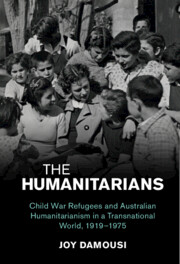 The Humanitarians
The Humanitarians Book contents
- The Humanitarians
- Studies in the Social and Cultural History of Modern Warfare
- The Humanitarians
- Copyright page
- Dedication
- Contents
- Acknowledgements
- Abbreviations
- Introduction
- Part I Saving
- Part II Evacuating
- Part III Assimilating and Adopting
- 7 Humanitarian Rights
- 8 Florence Grylls and Save the Children Fund
- 9 The Campaign for Japanese-Australian Children to Enter Australia
- 10 Humanitarian ‘Justice’
- 11 Humanitarian Activism During the Vietnam War
- Conclusion
- Select Bibliography
- Index
7 - Humanitarian Rights
UN World Refugee Year and UNICEF in Australia
from Part III - Assimilating and Adopting
Published online by Cambridge University Press: 28 July 2022
- The Humanitarians
- Studies in the Social and Cultural History of Modern Warfare
- The Humanitarians
- Copyright page
- Dedication
- Contents
- Acknowledgements
- Abbreviations
- Introduction
- Part I Saving
- Part II Evacuating
- Part III Assimilating and Adopting
- 7 Humanitarian Rights
- 8 Florence Grylls and Save the Children Fund
- 9 The Campaign for Japanese-Australian Children to Enter Australia
- 10 Humanitarian ‘Justice’
- 11 Humanitarian Activism During the Vietnam War
- Conclusion
- Select Bibliography
- Index
Summary
The formation of UNICEF in 1946 was a major turning point in humanitarian aid to children, and is discussed in Chapter 7. The United Nations (UN) initiated the World Refugee Year in 1959–1960 which was based on ideas of humanitarian rights – the right to access humanitarian aid. Children formed a major part of these campaigns in fundraising and drawing on support. While UNICEF did not promote adopting, it retained the Western model of fundraising support in Southeast Asia through campaigns of aid and development. Chapter 7 considers the role of UNICEF Australia in the region during the Vietnam War. Its campaign did so by depoliticising and decontextualising war by framing child refugees in neutral terms – as objects of humanitarian assistance to attract funds worthy of pity – rather than as victims of a political conflict, which would also demand a political analysis of US and Australian foreign policy. In doing so, it constructed an altruistic humanitarianism which framed donors as a community of secular heroes and saviours.
- Type
- Chapter
- Information
- The HumanitariansChild War Refugees and Australian Humanitarianism in a Transnational World, 1919–1975, pp. 195 - 224Publisher: Cambridge University PressPrint publication year: 2022
